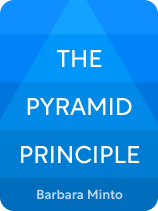

This article is an excerpt from the Shortform book guide to "The Pyramid Principle" by Barbara Minto. Shortform has the world's best summaries and analyses of books you should be reading.
Like this article? Sign up for a free trial here.
What’s the problem with unclear writing? Why will the traditional writing process fail you?
According to Barbara Minto in her book The Pyramid Principle, people often produce unclear writing that’s time-consuming and mentally taxing to read. This is because the typical writing approach fails to meet readers’ needs.
Below we’ll look at why the typical writing and reading process leads to unclear writing.
The Typical Writing Process
Minto argues that most people brainstorm ideas while they write, resulting in conclusions-last writing: writing that ends in a conclusion. First, they brainstorm ideas by writing sentences. Next, they review their ideas and consider how they relate to each other. Finally, they summarize these relationships in a concluding sentence. Here’s an example of conclusions-last unclear writing: “It was an achingly gorgeous fall day. I knew that winter was around the corner. I also knew that nothing on my to-do list was urgent. So I decided to spend my Monday afternoon strolling through my tree-lined neighborhood.”
(Shortform note: Minto claims that most people automatically produce conclusions-last writing, but whether or not this is true for you may depend on your cultural background. One expert on intercultural communication claims that everyone is capable of presenting information in a variety of orders, but every culture tends to prefer one order over the others. For instance, people from continental European cultures tend to present their conclusions last, whereas people from Anglo-Saxon cultures usually present their conclusions first.)
The Typical Reading Process
Whereas writers typically formulate conclusions after they generate ideas, Minto claims that readers naturally formulate conclusions while they read. Our brains are wired to automatically identify the logical relationships between ideas and develop conclusions that summarize those ideas. This process helps us remember information since it’s easier to recall a single conclusion than to remember the multiple separate points that support it.
(Shortform note: Research in psychology supports Minto’s claim that formulating conclusions about a group of ideas helps you retain information. According to psychologists, we naturally engage in chunking: a process in which we compile related information into a thematically related “chunk.” Chunking helps you hold information in your working memory (your brain’s system for temporarily storing information). As Barbara Oakley explains in A Mind for Numbers, chunking also helps you retain information over time: Your long-term memory also stores information in the form of chunks.)
Why Conclusions-Last Writing Overburdens Readers
Minto argues that unclear writing overburdens readers in two ways: 1) It makes reading more effortful and time-consuming, and 2) it confuses them. Let’s explore these two problems further, then illustrate them with an example.
Problem 1: Conclusions-Last Writing Makes Reading More Effortful
First, Minto argues that conclusions-last writing requires readers to expend time and energy forming conclusions as they read. When a writer doesn’t supply a conclusion up front, the reader defaults to their natural tendency of generating a conclusion themselves. This is a higher-order thinking skill that requires mental energy and slows down the reading process.
(Shortform note: Research supports Minto’s idea that it’s mentally taxing for readers to formulate their own conclusions. To formulate your own conclusions about a set of information, you engage in synthesis, a complex thinking process. When you synthesize, you summarize the information you read and use it to construct new meaning. Synthesis is a more complex and cognitively demanding thinking process compared to comprehension, which simply involves understanding information. A reader who encounters a conclusion at the beginning of a written piece can focus on comprehending the author’s conclusions, whereas a reader engaging with conclusions-last writing must expend mental energy synthesizing the author’s conclusions.)
Problem 2: Conclusions-Last Writing Creates Confusion
Second, according to Minto, conclusions-last writing can confuse readers. The conclusion that the reader forms as they read may differ from the author’s conclusion. When the reader finally encounters the author’s conclusion and notices it’s different from their own, they’ll likely become confused.
(Shortform note: Although Minto implies that you should avoid confusing your readers, research reveals that in some circumstances, confusion can actually improve people’s learning. When something you’re learning makes you confused, you become motivated to relieve that confusion. This motivation can deepen your engagement with the content and improve your memory of it. However, confusion only promotes learning and retention when learners have the skills and time to persist through that confusion. For instance, a reader with strong reading skills and the time to re-read may benefit from the confusion of conclusions-last writing. By contrast, someone with weaker reading skills or less time to re-read may not benefit from confusion.)
Example: A Conclusions-Last Opinion Piece
Let’s illustrate these two problems by considering this example of writing: “My workplace hosts a monthly, mandatory community-building lunch for employees. Some people arrive in high spirits because these lunches help them feel connected to others. Others arrive grumpy and stressed because they believe these lunches cut into their valuable work time.” (Note: This example omits the conclusion entirely.)
Most readers will automatically expend mental energy and time trying to find the similarities among these three sentences and summarize them into a conclusion. For instance, a reader might form this conclusion: “The writer is upset that some of their coworkers bring a negative attitude to work lunches.” Contrast this with the writer’s actual conclusion: “Some workplaces’ efforts to reduce employee burnout backfire when they make community-building activities mandatory.” Because the writer didn’t express this conclusion at the start of their paragraph, the reader interpreted the paragraph in a different way than the author intended. This lack of clarity could leave the reader feeling confused.

———End of Preview———
Like what you just read? Read the rest of the world's best book summary and analysis of Barbara Minto's "The Pyramid Principle" at Shortform.
Here's what you'll find in our full The Pyramid Principle summary:
- How to write so clearly that you can get a point across within 30 seconds
- How to write a clear, compelling introduction, body, and conclusion
- Why you should always start your prose with your conclusion and work backward






